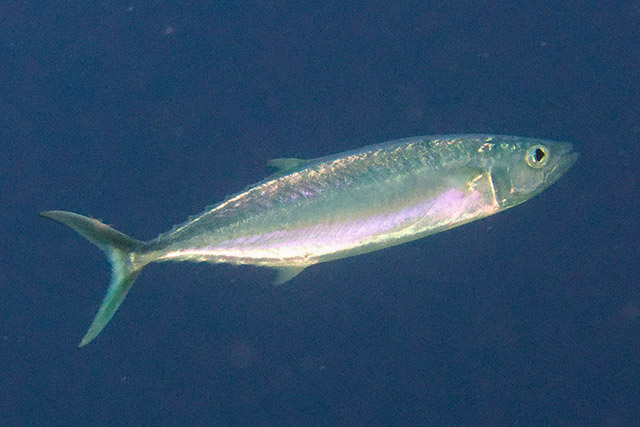| Scombridae (Mackerels, tunas, bonitos), subfamily: Scombrinae |
| 100 cm FL (male/unsexed); max.weight: 3,500.0 g |
|
reef-associated; marine; depth range 15 - 50 m, oceanodromous |
| Indian Ocean: Red Sea eastward to the Andaman Sea. Western Pacific: Ryukyu Islands to the northern coasts of Australia, including the Marshall Islands and Fiji. Often confused in the literature with Grammatorcynus bicarinatus. |
|
Dorsal spines (total): 11-13; Dorsal soft rays (total): 10-14; Anal spines: 0-0; Anal soft rays: 10-14. Mouth relatively small, upper jaw reaching about to middle of eye. Pectoral fins stout. Interpelvic process short and single. No prominent anterior corselet present. Swim bladder present. Vertebrae 14 precaudal plus 17 caudal, total 31 as in mackerel (Scomber and Rastrelliger).
Description: Characterized further by metallic blue-green, shading to silvery below; three keels on caudal peduncle and fin base, middle one largest; most of head and body covered with small scales; two lateral lines, second branching from first below third dorsal spine, passing ventrally along body, rejoining first below last dorsal finlet; large eye, 7-9% of fork length; maxilla reaching below middle of eye; jaws with 20-30 slender conical teeth; vomer and palatines with a patch of small teeth; maximum weight about 3.5 kg (Ref. 90102). |
| Inhabits open water but often seen swimming near outer reef walls or deep clear-water slopes (Ref. 48637). Found mostly in shallow reef waters where it forms large schools. Feeds on crustaceans and fishes, particularly clupeoids (Sardinella, Thrissocles), and other fishes such as Sphyraena and Balistes. Marketed canned and frozen (Ref. 9684). Its flesh is mild and pleasantly flavored, but brushed with lemon juice prior to cooking to remove the ammonia-like smell (Ref. 9684). |
|
Least Concern (LC); Date assessed: 01 March 2022 Ref. (130435)
|
| harmless |
Source and more info: www.fishbase.org. For personal, classroom, and other internal use only. Not for publication.
